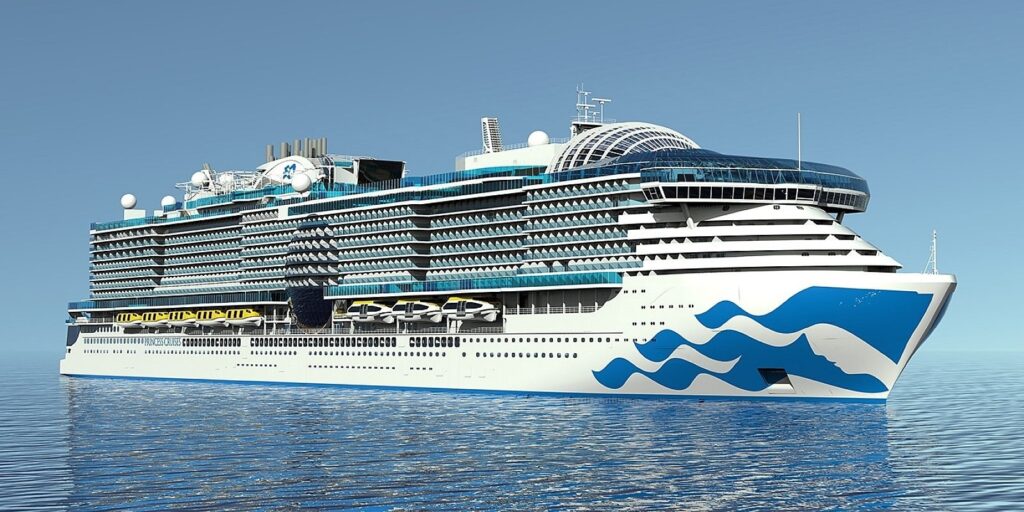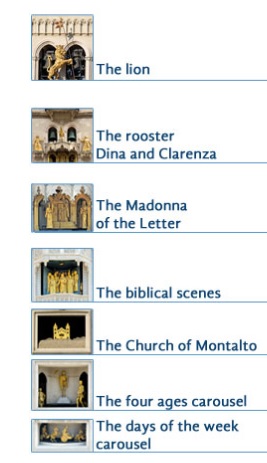Divine Feminine Mediterranean Cruise
February 28 to March 9, 2024 – SOLD OUT
11 Days
$5000 for exterior cabin with Balcony, maximum 2 people, their names are required
$7000 for exterior cabin with Balcony, for family of four, their names are required
Full Payment is refundable if you cancel by November 1, 2023
Deposit to Hold Placement for one person/tour
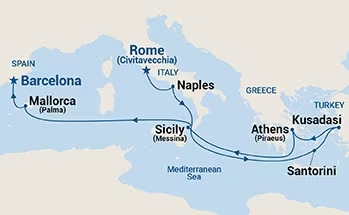
This is the Divine Feminine Mediterranean Cruise in our 5-part Divine Adventure tour series. Take all tours or just this one.
| Wed, 02/28/24 | Rome (civitavecchia), Italy View general port information |
– 6:00pm |
| Thu, 02/29/24 | Naples, Italy (for Capri & Pompeii) | 7:00am – 6:00pm |
| Fri, 03/01/24 | At Sea | |
| Sat, 03/02/24 | Santorini, Greece Water Shuttle Required wheelchair Access Limited |
9:00am – 7:00pm |
| Sun, 03/03/24 | Kusadasi, Turkey (for Ephesus) | 8:00am – 6:00pm |
| Mon, 03/04/24 | Athens (piraeus), Greece | 7:00am – 6:00pm |
| Tue, 03/05/24 | At Sea | |
| Wed, 03/06/24 | Sicily (messina), Italy | 8:00am – 6:00pm |
| Thu, 03/07/24 | At Sea | |
| Fri, 03/08/24 | Mallorca (palma), Spain | 8:00am – 6:00pm |
| Sat, 03/09/24 | Barcelona, Spain View IMPORTANT information |
DAY 1 FEB 28

CIVITAVECCHIA PORT
Our Divine Group will meet a 5:45 pm for our Divine Celebration dinner commemorating our new Divine Adventures and to enjoy exhilarating conversation especially from our Divine Tour Director who will share information about our Divine shore excursions and her Divine Feminine mission. And every evening at 6 pm, hereafter, we will meet our Divine Tour Director & group for dinner.
CRUISESHIP EMBARKS 6PM
DAY 2 FEB 29
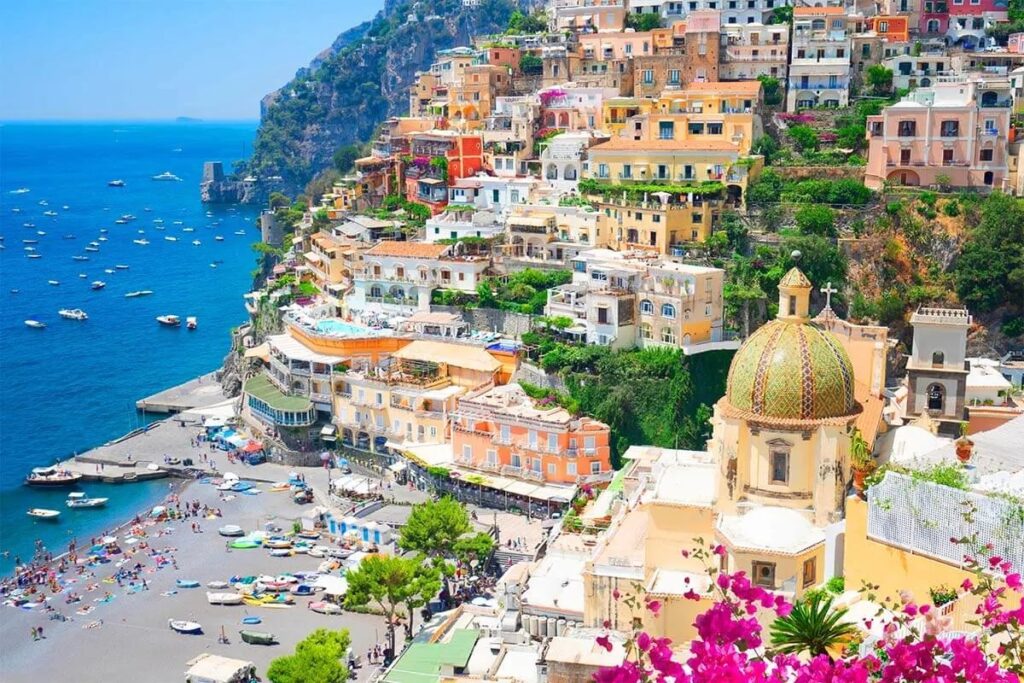 Naples, Italy (for Capri & Pompeii)
Naples, Italy (for Capri & Pompeii)
Time in port: 7:00AM – 6:00PM
We’ll tour Italy’s third-largest city, Naples, a bustling metropolis famed for it stately buildings, restaurants, and the creation of pizza. We’ll see a beautiful city rich in centuries-old culture and customs.
We’ll see the ruin remains of Roman cities and the fabled stunning Amalfi Coast where there’s a gateway to the Isle of Capri.
We’ll see the ruins of Pompeii, buried in ash by the cataclysmic eruption of Mt. Vesuvius in 79 A.D.
We’ll stop for lunch in the city center.
DAY 3 MARCH 1
At Sea
DAY4 MARCH 2
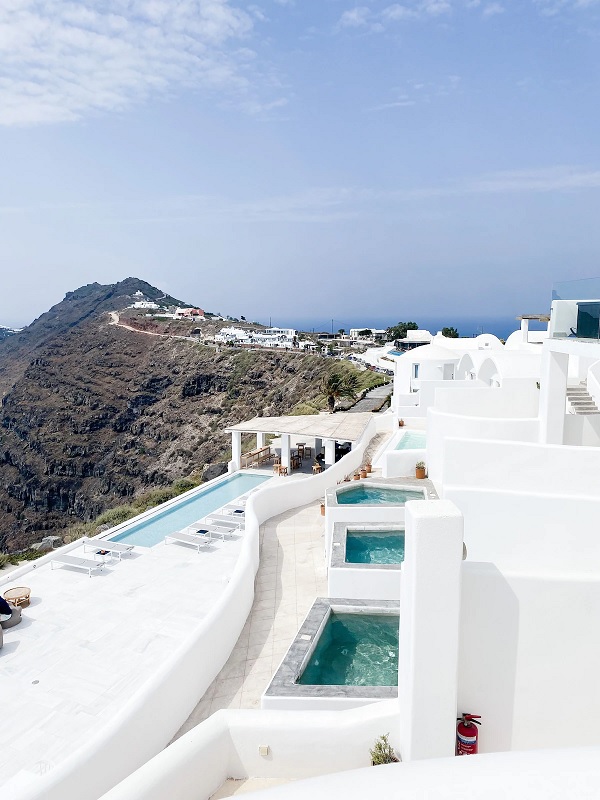 Santorini, Greece
Santorini, Greece
Time in port: 9:00AM – 7:00PM
Circa 1600 B.C. Santorini’s population might have been ravaged by a volcanic eruption which also may have destroyed the nearby ancient Minoan civilization on Crete. Some say Atlantis originated in the caldera of Santorini. Whether the Lost Continent of Atlantis is rooted in myth or reality, an undisputed fact remains. The eruption created a caldera – and one of the most dramatic land and seascapes in the entire Mediterranean.
In 1967, archaeologists on Santorini unearthed the remains of a Bronze Age city that may have been home to as many as 30,000 people. The good news is the caldera is no longer active. And we can see the island safely.
We’ll visit Santorini’s village Fira and admire it’s whitewashed buildings that sit purposefully atop vertiginous cliffs without plunge to the turquoise sea below. The vistas are incredble.
Part of the Cyclades Archipelago, the three-island group of Santorini, Thirasia and uninhabited Aspronisi present the traveler with unforgettable vistas.
The island has had a number of names throughout history – from Strongyle or “Round” to Thera in honor of an ancient hero.
Santorini is more recent and stems from the island church dedicated to St. Irene – Santa Rini to foreign sailors. We’ll visit this church and find inspiration from the Divine Feminine. Later, we’ll have an opportunity check out the shops and eat lunch in one of the restaurants with a beautiful vista to enjoy.
Note: Santorini is an anchorage port: passengers transfer to shore via shore tender.
DAY 5 MARCH 3
Kusadasi, Turkey (for Ephesus)
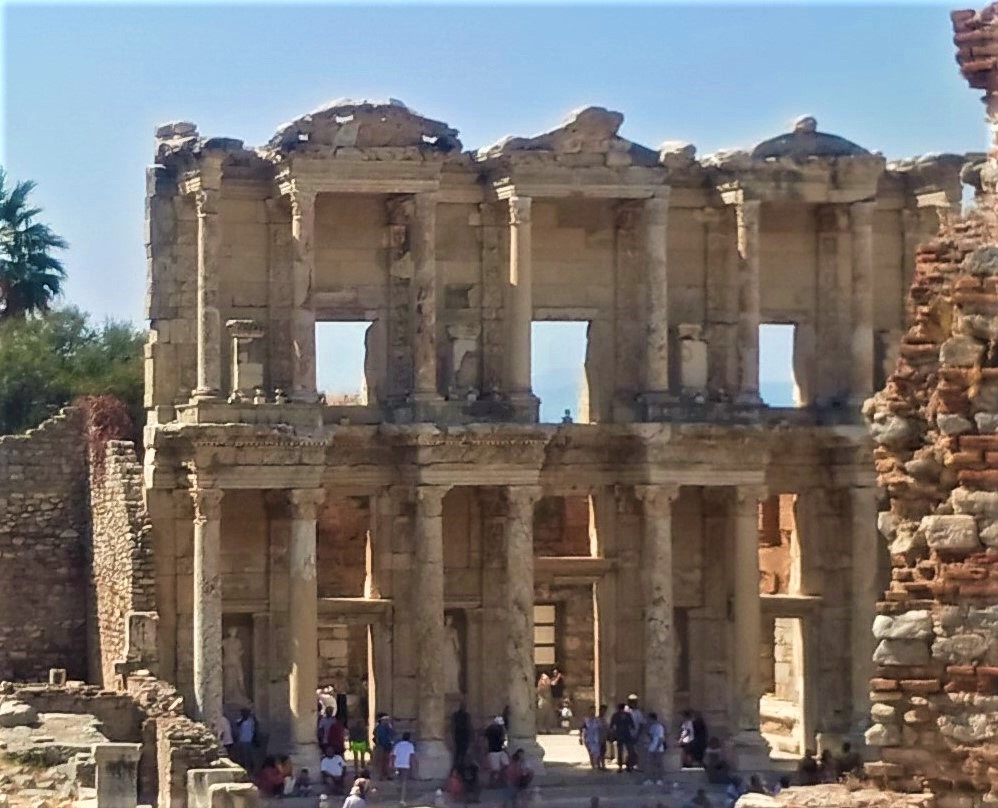
Time in port: 8:00AM – 6:00PM
The port of Kusadasi on Turkey’s Anatolian Coast is a mixture of whitewashed stone houses rise in tiers behind the market district with thousands of merchants offering wares to rival the Grand Bazaar in Istanbul.
Our Divine Group will travel past a palm-lined street of Kusadasi onto Ephesus where multilayers of ancient civilization exist for our exploration as we search for signs of the Divine Feminine.
Ephesus was one of the “12 Ionian Cities” that were famous trading centers and ports in the 10th century BC. Ephesus led the “cradle of civilization” spiritually, as well as, materially.
Around 546BC. Kusadasi was invaded by Persians. In 200BC its environs were dominated by the Roman Empire, and with the division of the Roman Empire, became a state of Byzantine. As the changes in climate caused serious earthquakes and changed the route of Caystros River, Ephesus was mostly destroyed and lost its prior importance and prosperity. The result had forced Byzantines to search for a new port and a new road that would be suitable for trading, the “silk road”. Kusadasi took the lead once held by Ephesus. But, it didn’t loose it’s spiritual importance. Something was buried there a long time ago, the “One great opus”, the alchemical egg and it’s still being protected by the one who put it there.
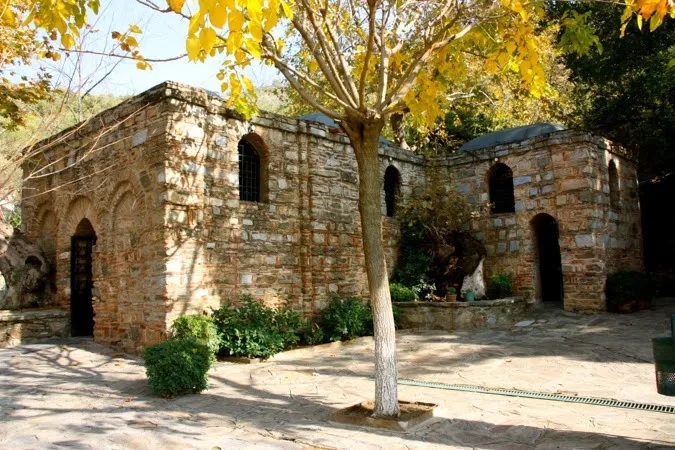 Ancient Ephesus is a major archeological site where recent excavation reveals the more recent ruins of examples of Terrace Houses with beautiful interiors where wealthy Roman citizens lived their domestic life style.
Ancient Ephesus is a major archeological site where recent excavation reveals the more recent ruins of examples of Terrace Houses with beautiful interiors where wealthy Roman citizens lived their domestic life style.
The city Ephesus was once a Roman provincial capital and trading center which covered over the more ancient goddess cradle of civilization that protected the evolution of the human races on the planet. This protective veil of the divine planet earth would be lifted at the right time once people had had enough of the “shadow” and want to know about the Divine Feminine. To learn more about the “Divine Plan” come on our Divine Adventure.
Our Divine Group will pass through the arched Magnesian Gate at the Ephesus archand begin a slow, downhill walk to the ruins of the Roman provincial capital, where our guide will highlight such pivotal sights as the Temple of Hadrian, the magnificent Trajan Fountain, the Odeon Theater, the beautiful Celsus Library (refer right) and the dramatic Great Theater.
The town of Ephesus was also one of Christendom’s sites. St. Paul preached at the Great Theater. The ruins of Ephesus’ Basilica cover the tomb of Christ’s most beloved disciple, St. John the Apostle.
The House of Virgin Mary is a Catholic shrine located on Mt. Koressos 4 miles from town in a tranqual setting where we can contemplate it’s spiritual significance. It was discovered by Anne Catherine Emmerich, an Augustian German nun, who had visions of the house in the early 19th century. She described the structure almost perfectly – from her home in Germany.
We’ll return to our ship with freetime at our leisure until we meet a 6pm for dinner and complete our exhilarating day.
DAY 6 MARCH 4
Athens (piraeus), Greece
Time in port: 7:00AM – 6:00PM
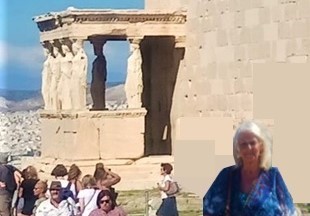
The vibrant cradle of Western civilization is an inspiration. 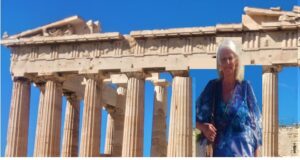 Piraeus is the port city for Athens and has been Athens’ port of entry for over two millennia.
Piraeus is the port city for Athens and has been Athens’ port of entry for over two millennia.
We’ll see the Acropolis, the greatest of all archeological sites, the Acropolis dominates the Athenian landscape. Ascend 800 steps, taking in the views we’ll marvel at such glorious monuments as the Parthenon (on the below) and the Erechtheum also know as Temple of Athena (refer left). which sits above the commotion of the modern city of Athens below.
There’s the hustle and bustle of the modern Athens, a metropolis of 4.5 million that spreads out from the foot of Mt. Lycabettus and across the plain. Meanwhile tragedies of Aeschylus, Sophocles, and Euripides are performed in the well preserved ampi-theater of Dionysus at the foot of the Acropolis.
And above the commotion the serene Parthenon sails on while citizens of a fledgling democracy gathered on Pnyx Hill to cast their votes on Athens’ destiny. Packed with busy shops and lively tavernas, modern Athens is a colorful counterpoint to classical Greece.
We’ll return to our ship with freetime at our leisure until we meet a 6pm for dinner and complete our exhilarating day.
DAY 7 MARCH 5
At Sea
After our 6pm dinner gathering we’ll highlight the evening with spectacular theater entertainment.
DAY 8 MARCH 6
Sicily (messina), Italy
Time in port: 8:00AM – 6:00PM
Messina has played a major role in European history since its founding as a Greek colony in the 8th century B.C. During the Roman Empire, the city was a major port and commercial center, during the Middle Ages, Messina was the major port of departure for Crusaders. History has also left its scars: a massive earthquake leveled much of the city in 1908 and the World War II campaign for Sicily devastated Messina. Yet Messina emerged from that devastation with some of its historic treasures intact, including the 12th-century Annunziata dei Catalani Church. Messina is also your gateway to the rugged beauty of southeast Sicily, from the seaside resort of Taormina to Mt. Etna.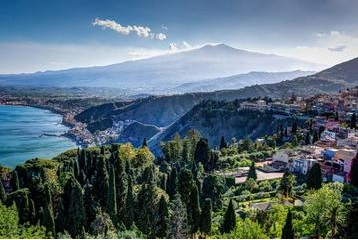
Between the fall of Rome, the 1282 attack on Messina and the 1861 unification of Italy, the Arabs, the Normans, the Germans, the Spanish and the French ruled Sicily.
Messina Piazza del Duomo, Ganzirri & Faro
 Our Divine Group will step through the “door of Sicily” and explore Messina’s magnificent historic highlights. This bustling town has a complex history with roots in Greek mythology.
Our Divine Group will step through the “door of Sicily” and explore Messina’s magnificent historic highlights. This bustling town has a complex history with roots in Greek mythology.
We’ll begin at the Messina Harbour where a golden statue of the Divine Mother callled the Madonna of the Letter – Stele della Madonna della Lettera – stands atop a spire at the sea entrance to the harbor of Messina. The Divine Mother became the patron saint of the city after she sent a letter to the citizens of Messina, saying, “We bless you and your city” in Latin “Vos et ipsam cictatem benedicimus” which was inscribed on the golden statue’s pedestal in 1900.
We’ll travel along the northern coast of Sicily to reach Cape Peloro and continue through villages of Ganzirri & Faro & small salt water lakes used for growing mussels. And return to Messina, stopping at Cristo Re to take in the breath-taking city views before heading to the Piazza del Duomo.
Once at the Piazza, we’ll stroll over to the Fontana di Orione and toss in a coin and make a wish.

Piazza del Duomo
Piazza Duomo is the main square in Messina, Sicily and it contained some marvelous structures that had been restored, repaired or replaced over several centuries. The square is also known by the name Cathedral Square where we’ll marvel at the 12th century cathedral, originally built in Norman times. It’s façade features three 16th-century entry doors and a 180-foot high bell tower that holds the world’s largest astronomical clock.

The Lion That Roars and Moves
The Lion
Inside the Messina Duomo Cathedral once high noon commences so do the various pieces of it’s amazing astronomical clock. Representing the Divine 7th level, the crown chakra, the lion’s tail moves, he waves his flag, and he roars*. Then the figures in the windows – and there are many openings and bronze figures – begin to rotate or move. Each figure has a meaning or association. This lion represents Messina, and its strength. The rooster directly below represents the 6th Level, the intuitive 3rd eye, awakening. It moves as well with wing flaps, and head lifts. It also crows after the lion roars. Two statues of women either side of the crow signal the hours and quarter hours by beating on the bells. These two are actual historical figures: Dina and Clarenza who saved the city from a surprise attack from Saracens during the Vespers war siege in 1282.

The Rooster & Two Heroines

Inside View of the Madonna della Lettera Carousal
(Images: Bigstock)
On the 5th level
In the centre of the bell tower below the rooster is another opening featuring a moving tableau of figurines. These are an angel, St. Paul and three ambassadors of Messina who appear and disappear through “doorways” around the static figure of the Madonna della Lettera. The Madonna supposedly sent a letter to the city offering eternal protection via the ambassadors sent by St. Paul to her in Jerusalem. These figures also bow to the Virgin before rotating on.
Yet another mechanical symbol appears on the bell tower: the church of Monalto rises from a rocky hill and a dove circles it in flight. This scene depicts the story of Fra Nicola, his vision, and the building of the Monalto church in 1294.
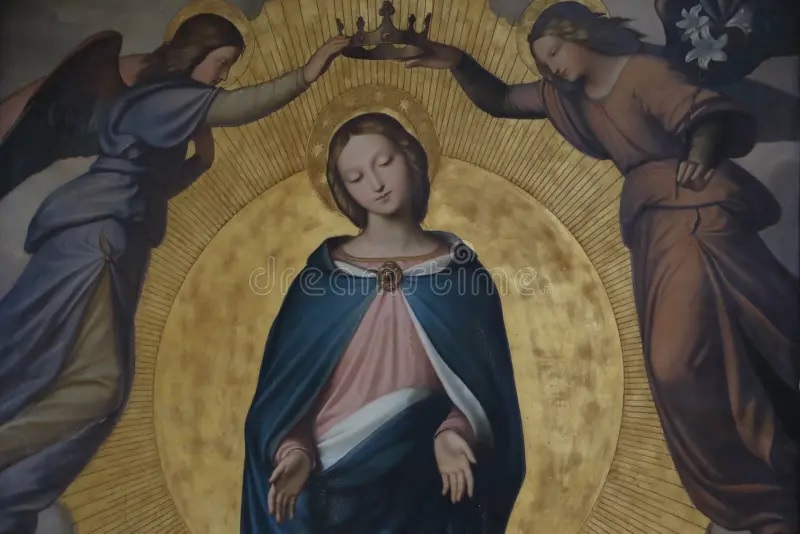
NOTE: At the Messina Duomo Cathedral, we’ll see the spectacular church treasury filled with the centuries worth of the gifts donated as tokens of faith by kings and peasants alike. Among the many spectacular art pieces is a superb golden mantle in honor of the Madonna. (refer above)
The Madonna della lettera and the Ambassadors

On the 5 level, the speech chakra level several scenes are dedicated to the Madonna of the Letter, where an angel brings the letter to the Divine Mother followed by St. Paul and the ambassadors who bow when passing in front of the virgin. The statues of the ambassadors bow in turn before the Madonna, who holds the letter of blessing in one hand. According to tradition, the Apostle Paul arrived in Messina in 42 AD and began the work of converting the local population to Christianity. When he returned to Palestine, a delegation from Messina wanted to accompany Paul on his journey, so that they could meet the Divine Mother and ask for a blessing for their city.
The people of Messina were able to meet the Divine Mother on 3 June 42 AD. In gratitude, Mary gave them a letter of blessing, written in Hebrew and bound with a lock of her hair.
Biblical stories
On the fourth level, the heart chakra level, biblical stories are represented. The statues that can be seen on the façade vary according to the time of year and, in particular, according to the liturgical calendar. From Christmas to Epiphany, the scene is that of the adoration of the shepherds. When the mechanism is activated, the shepherds parade bowing before the baby Jesus, the Divine Mother and St Joseph.
Sanctuario of Madonna di Montalto
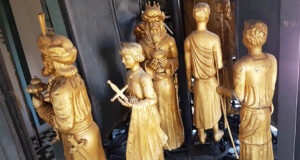 On the third level, the power chakra level, we find a reference to another town legend related to the construction of a church. Apparently, in 1294, the Divine Mother appeared in a dream to a monk named Nicholas with a specific request. The next day, he was to gather the city authorities on the Colle della Caperrina (Caperrina Hill). At midday, a dove is said to have circled the perimeter around which a church dedicated to the Divine Mother was to be built.
On the third level, the power chakra level, we find a reference to another town legend related to the construction of a church. Apparently, in 1294, the Divine Mother appeared in a dream to a monk named Nicholas with a specific request. The next day, he was to gather the city authorities on the Colle della Caperrina (Caperrina Hill). At midday, a dove is said to have circled the perimeter around which a church dedicated to the Divine Mother was to be built.
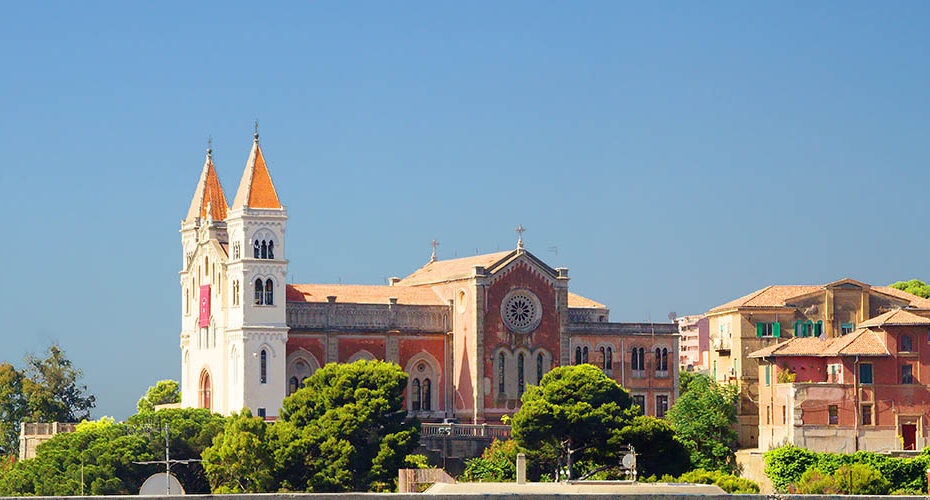
The mechanisms of the Astronomical Clock re-enact this story every day at midday. As a dove takes flight, the statue of the Church of Montalto slowly emerges.
In 1295, the church was completed and dedicated to the Blessed Virgin of Montalto. The 1908 earthquake completely destroyed this church and the adjoining monastery that had been built in 1389. The Santuario di Montalto would be built on these very sites in 1928.
The stages of life carousel
On the second penultimate level, the life force sexual chakra, is representing a life carousel with four statues of 4 different periods of life: childhood, adolescence, adulthood and old age. Every quarter of an hour, the statues of a child, a young man, a warrior and an old man move in procession before death. This is represented by a skeleton with a scythe in its hand which moves as they pass.
The days of the week carousel
The first level, the time frame of physical earth life chakra depicts the days of the week personified by seven Roman gods. Each of them is driving a chariot pulled by different animals. For Monday, there is Diana, goddess of the hunt, pulled by a deer. For Tuesday, there is the god of war, Mars, on a chariot pulled by a horse. Mercury is for Wednesday, and the animal attached to his chariot is a panther. Jupiter, the father of the gods, is for Thursday and a mythological “chimaera” pulls his chariot. Venus, the goddess of beauty, is for Friday, driving a chariot with a dove attached. Saturn is for Saturday, and his chariot also sports a chimaera. Finally, for Sunday, there is Apollo, whose chariot is equipped with a horse.
The astronomical clock on Messina Cathedral’s Bell Tower
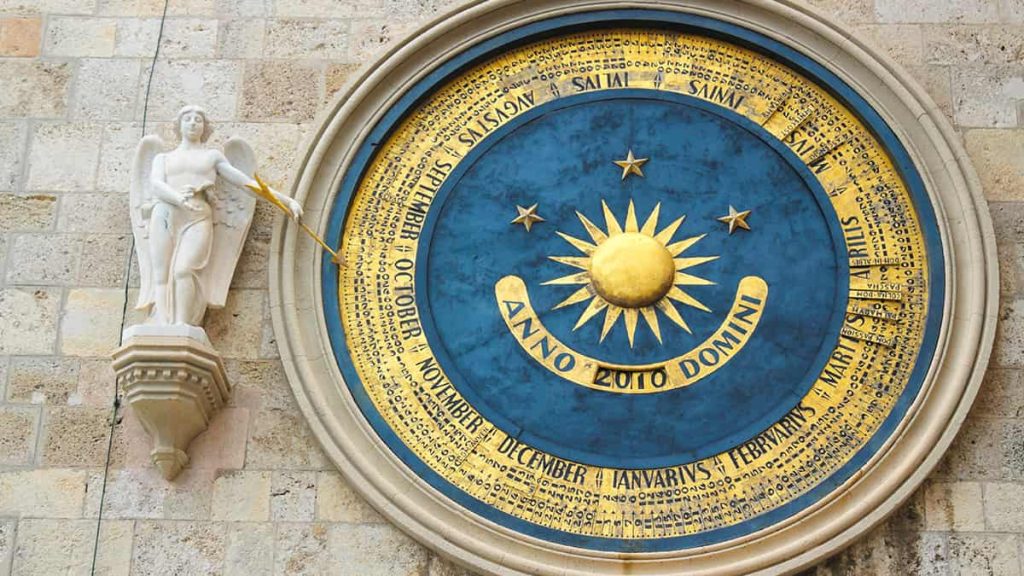
On the side of the bell tower there’s an Zodiac clock. Starting from the top, a half-gold, half-black sphere marks the different phases of the moon.
On the lower level, there is a planetarium consisting of a large ring depicting the solar system and the figures of the zodiac.
Finally, below the planetarium, is the large perpetual calendar disc.
At the exact centre is a sun and around it, in concentric circles, the days and months of the year are indicated. On the left, the statue of an angel indicates, with an arrow, the current date and year, which is automatically updated at midnight.
Special Notes:
Still and video photography are not allowed inside Cathedral Treasury. Appropriate attire is required when visiting the Cathedral. Tour order may vary but all sites listed will be covered. Use of an audio headset (included) will enhance your tour experience.
We’ll return to our ship with freetime at our leisure until we meet a 6pm for dinner and complete our exhilarating day.
DAY 9 MARCH 7
At Sea
DAY 10 MARCH 8
Mallorca (palma), Spain
Time in port: 8:00AM – 6:00PM
Palma is the capital city of the island of Mallorca, which is one of Spain’s Balearic Islands. The city is tucked into the protected Bay of Palma, creating an impressive view from the Mediterranean Sea with its imposing Gothic Cathedral towering above the old town and remnants of medieval walls that testify to its ancient history. Mallorca has a varied history, from the Roman occupation in the 2nd century to Moorish control from the 9th to the 13th century. Later reconquered by the Spanish kings, it rose to wealth and power due to its strategic position along the seagoing trade routes between Africa and Europe.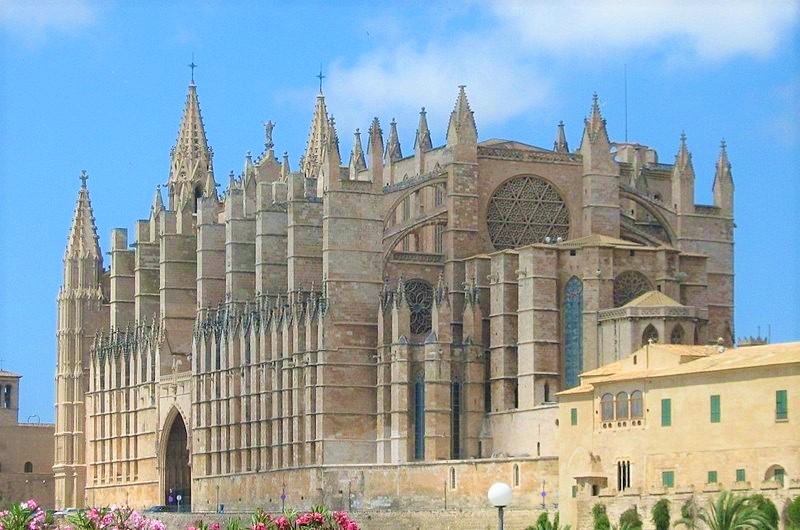
Today, Palma is the largest city, and also the main tourist area, with beaches on either side of the city that overflow with resort hotels. If you venture beyond these environs, the island’s natural beauty abounds, and life continues in a predictably underdeveloped atmosphere of simplicity. This aspect has long been an attraction for writers, painters and musicians that find inspiration here.
Two main languages are spoken on Mallorca – Castilian Spanish and the Balearic dialects of Catalan – hence the different versions of names and spellings throughout the Balearic Islands.
We’ll visit The Cathedral of Santa Maria of Palma more commonly referred to as La Seu which is a Gothic Roman Catholic cathedral located in Palma, Mallorca, Spain.
Construction of the Cathedral of Mallorca started in the 13th century and ended in the 1630s. The Cathedral is in the Mediterranean Gothic tradition, but over the centuries, it has incorporated the cultural forms of the modern and contemporary periods.
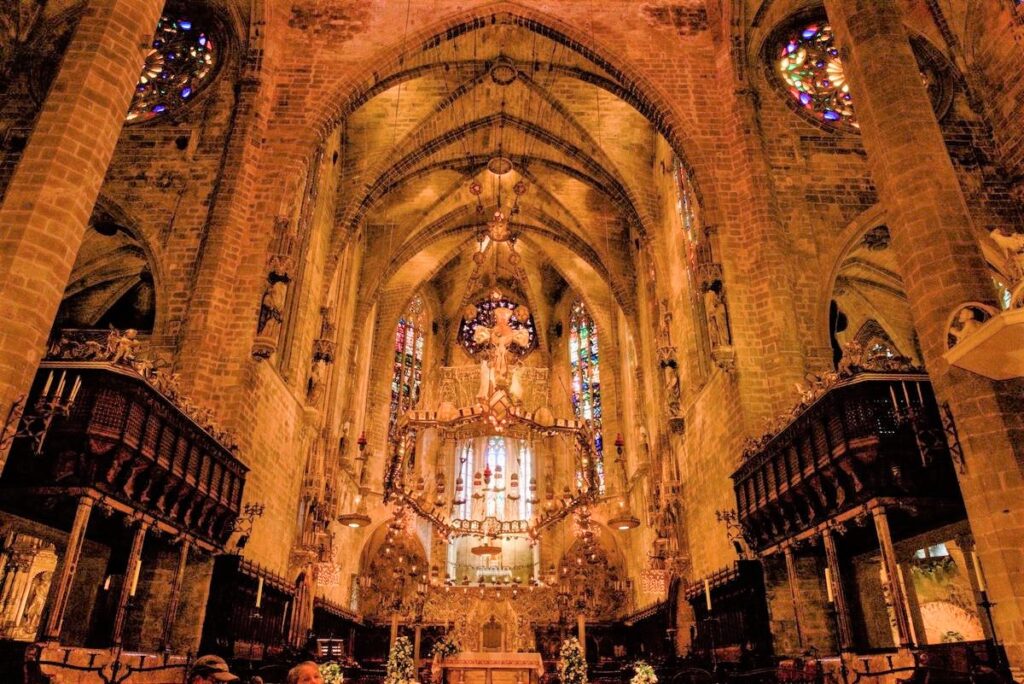 The history of the Cathedral is intimately linked to the local monarchy. After the conquest of Madina Mayurqa in 1229, James I, who was king of Aragon and count of Barcelona, ordered the consecration of the former great mosque to the Virgin Mary as a site for Christian worship and the building of a new church in the style of that time, using part of the site of the old mosque. Designed in the Catalan Gothic style, but with Northern European influences, it was begun by King James I of Aragon in 1229 but only finished in 1601. It sits within the old city of Palma atop the former citadel of the Roman city, between the Royal Palace of La Almudaina and the episcopal palace. It also overlooks the “Parc de la Mar” and the Mediterranean Sea.
The history of the Cathedral is intimately linked to the local monarchy. After the conquest of Madina Mayurqa in 1229, James I, who was king of Aragon and count of Barcelona, ordered the consecration of the former great mosque to the Virgin Mary as a site for Christian worship and the building of a new church in the style of that time, using part of the site of the old mosque. Designed in the Catalan Gothic style, but with Northern European influences, it was begun by King James I of Aragon in 1229 but only finished in 1601. It sits within the old city of Palma atop the former citadel of the Roman city, between the Royal Palace of La Almudaina and the episcopal palace. It also overlooks the “Parc de la Mar” and the Mediterranean Sea.
In 1901, fifty years after a restoration of the cathedral had started, Antoni Gaudi was invited to take over the project. Gaudi abandoned his work in 1914 after an argument with the contractor. The planned changes were essentially cosmetic rather than structural, and the project was cancelled soon after.
The rest of the day is at your leisure in Mallorca. Some will return to the ship. While others will continue exploring Mallorca and return later to the ship, in time for our gathering at 6 pm.
We’ll meet for our Divine Celebration dinner commemorating and congratulate the Divine for the successful completiion of our Divine Adventure. We’ll have Divine stories to share.
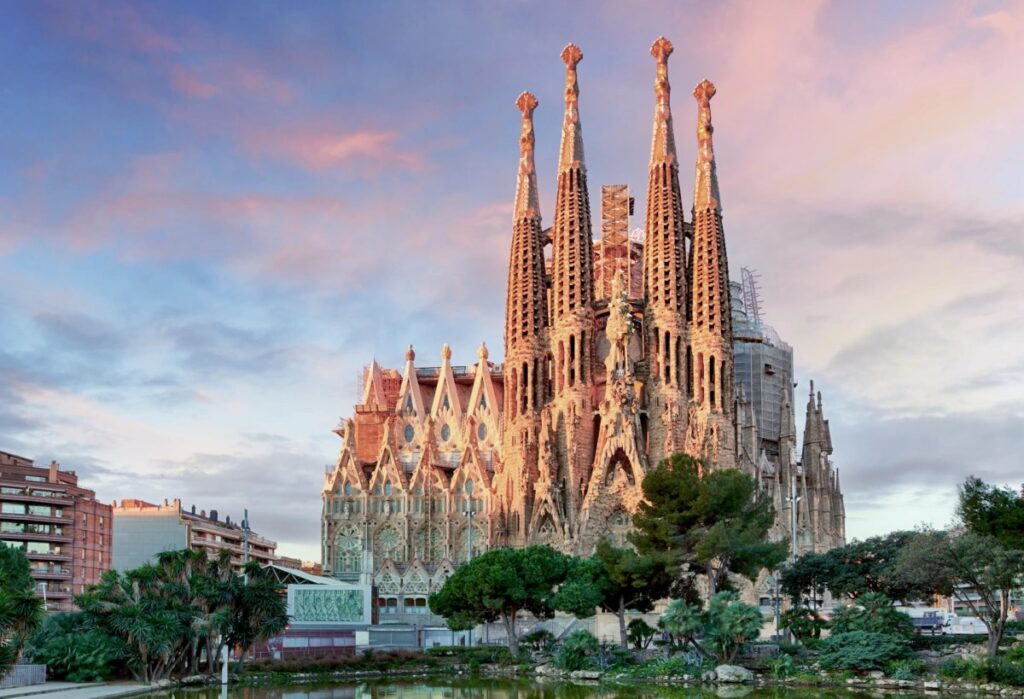
DAY 11 – MARCH 9
Barcelona, Spain
Time in port: 6:00AM – Disembarkation schedule will be delivered to your stateroom.
We’ll make our way to one of the most iconic landmarks in Barcelona,
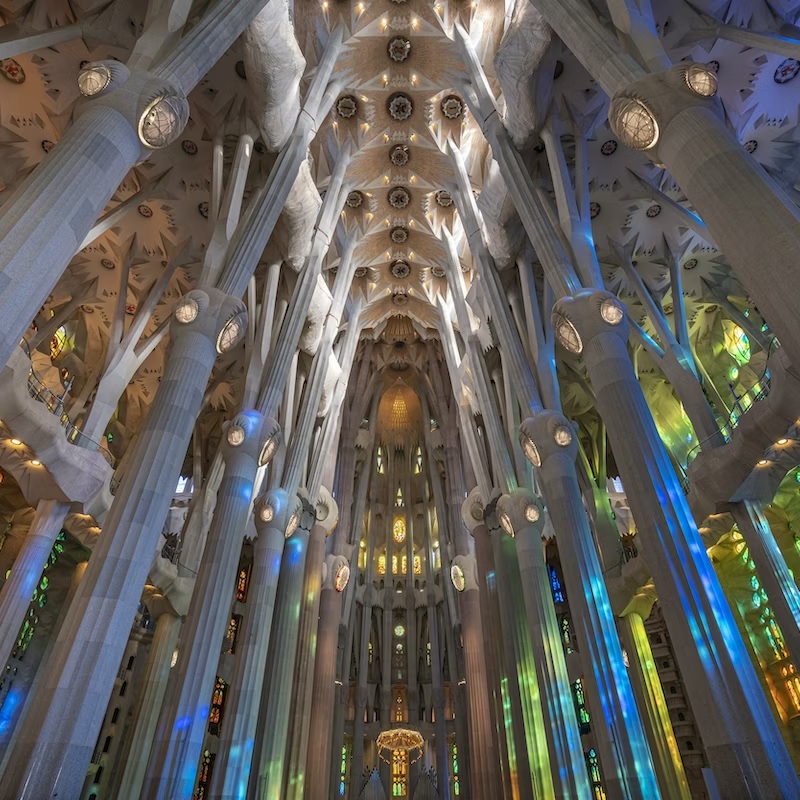
Spain and marvel at the spires of Gaudi’s Basilica La Sagrada Familia.
When Sagrada Familia is finally finished in 2026 – on the 100th anniversary of Gaudí’s death – the Sagrada Familia will have taken a whopping 144 years to complete. The Great Pyramid of Giza, by comparison, took just 20 years.
Once you’re inside, prepare to be mind-blown by Gaudí’s modernist, yet unfinished masterpiece. Look up at the spires that tower over the Catalan capital. See the sunlight sending rainbows streaming in through the stained-glass windows. Every inch of this basilica has the wow-factor!
Look for the turtle at the base of one pillar, and the tortoise at another. These are designed to show the balance between land and sea. In fact, there are decorations inspired by nature and Christian iconography everywhere.
Our tour group will travel by train to Montserrat Benedictine Monastery Complex, approximately 30 miles, northeast of Barcelona. This wonderful monastery, considered Catalonia’s most important religious retreat, is hidden high in the craggy Montserrat Mountains. The world’s oldest publishing house, established in 1499, is also located here.
Montserrat Mountain has had religious significance since pre-Christian times. Before Christ a temple was built here by the Romans to worship Venus.
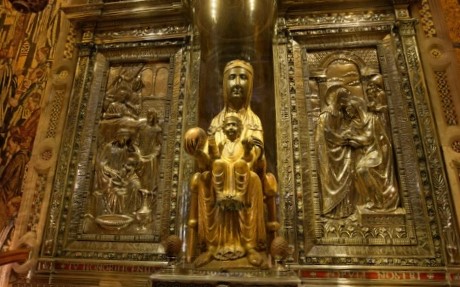 The Montserrat Black Madonna has a long and fascinating history that dates back to the 12th century. According to legend, the statue was discovered by shepherds in the mountains of Montserrat, who saw a bright light and heard angelic voices coming from a cave. When they investigated, they found the statue of the Virgin Mary holding the infant Jesus.
The Montserrat Black Madonna has a long and fascinating history that dates back to the 12th century. According to legend, the statue was discovered by shepherds in the mountains of Montserrat, who saw a bright light and heard angelic voices coming from a cave. When they investigated, they found the statue of the Virgin Mary holding the infant Jesus.
Over the centuries, the devotion to the Montserrat Black Madonna grew, and the statue became an important symbol of Catalan identity and spirituality. The Montserrat Basilica and Monastery were built to house the statue and to provide a place of pilgrimage for the faithful.
The original statue of the Montserrat Black Madonna was destroyed during the Napoleonic Wars in the early 19th century. However, a replica was created and is now venerated in the basilica. The statue is made of wood and is about 95 centimeters tall. It depicts the Virgin Mary standing, holding the infant Jesus in her left arm, and a globe with a cross on top in her right hand.
The statue’s black color is one of its most distinctive features and has long been the subject of speculation and interpretation. Some believe that the statue’s color is due to the natural oxidation of the wood, while others see it as a symbol of the Virgin Mary’s connection to the earth or as a representation of her mourning for the suffering of humanity.
 Despite the many theories and debates surrounding the statue’s origins and symbolism, one thing is clear: the Montserrat Black Madonna has played a significant role in the history and culture of Catalonia and is a beloved symbol of faith and hope for millions of people around the world.
Despite the many theories and debates surrounding the statue’s origins and symbolism, one thing is clear: the Montserrat Black Madonna has played a significant role in the history and culture of Catalonia and is a beloved symbol of faith and hope for millions of people around the world.
During the Franco dictatorship, hundreds of persecuted people were hidden there. More than 20 monks were executed because of it.
Today, this resistance makes the monastery an important symbol of Catalan self-evidence and the fight against oppression. The Catalans are still grateful for that today.
We’ll return to Barcelona is one of the world’s greatest treasures. Vibrant and earthy, commercial and cultural, Barcelona is a city of two million residents is the capital of Spain’s autonomous region of Catalonia.
It’s nurtured such artistic giants as Picasso, Dali, Miro and Casals, is definitely a traveler’s paradise and home to world-class parks, fountains and museums. It was the sponsor of the 1992 Summer Olympics.
We’ll say our goodbyes and make our transfers to our next destinations. Some will continue on to our 5th Divine Adventure in Paris.
Tip:
Bring European electric plug adapter for your appliances.
*CTS Tours reserves the right to make changes to our tour’s shore excursion itinerary, Divine Feminine Mediterranean Cruise, for the benefit and success of the tour. CTS Tours will follow the itinerary as best it can, with possible changes in the future, additions or subtrations of shore excursions so they will run smoother.
CTS Tours doesn’t guarantee the accuracy of the cruise description and if the cruise is changed or cancelled, in the future, CTS Tours is not be held responsible. This is why you are responsible for getting trip insurance.
951-357-9516

